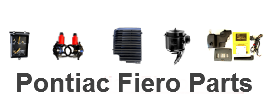Posted by Support Staff on 5th May 2017
What do Pontiac Fiero Diagnostic Trouble Codes mean

Code 12
This code will flash whenever the diagnostic terminal is grounded with the ignition in run, and the engine off.
If this code appears while the engine is running, no reference pulses from the distributor are reaching the ECM.
Code 13 (Oxygen Sensor Circuit Failure - open)
If the computer see the circuit open it will set code 13.
Make sure the Sensor is not disconnected.
Also check for a sticking or miss adjusted Throttle Position Sensor.
Code 14 (Coolant Sensor - low voltage)
The
Coolant Sensor is actually a thermistor. Low resistance in the Coolant
Sensor Circuit will cause the ECM to set Code 14. As temperature goes
up- resistance in the Sensor should go down. Too low resistance
indicates a faulty Sensor The lower its resistance, the higher the
coolant temperature. The ECM will set Code 14 if the engine overheats
(temperature higher than 135°C/275°F for longer than 3 seconds), or when
there's a problem with the sensor.
Code 15 (Coolant Sensor - high voltage)
The
Coolant Sensor should never have infinitely high resistance, the
measured voltage should be lower than the reference voltage. A problem
exists with the Coolant Sensor if the measured voltage is the same as
the reference voltage. The ECM will set this code when it detects a
problem with the Coolant Sensor.
Code 21 (Throttle Position Sensor - high voltage)
Indicates a problem with the Throttle Position Sensor. Check for a sticking or miss adjusted TPS plunger.
Code 22 (Throttle Position Sensor - TPS low voltage)
Indicates a problem with the Throttle Position Sensor.
Code 23 (Manifold Air Temperature) (V6 only)
If
the ECM detects a problem with the MAT sensor will set Code 23. Check
all connections and replace the MAT sensor if necessary.
Code 24 (Vehicle Speed Sensor)
Indicates a problem with the VSS (ECM does not receive any speed pulses while driving).
Code 25 (Manifold Air Temperature) (V6 only)
If
the ECM detects a problem with the MAT sensor (unusual high temperature
reading), it will set Code 25. Check all connections and replace the
MAT sensor if necessary.
Code 32 (EGR Vacuum Control)
The
most common cause for this trouble code is a leak in the EGR vacuum
lines. The second most common cause is a defective EGR solenoid. The EGR
solenoid should not be energized and vacuum should not pass to the EGR
valve. The diagnostic switch should close at about 2 inches of vacuum.
With vacuum applied, the switch should close. Check the EGR vacuum lines
for leaks. Replace the EGR solenoid. Replace the EGR valve.
Code 33 (Manifold Absolute Pressure Sensor) (MAP)
The
ECM will set code 33 when a problem with the MAP sensor is detected
(unusual low vacuum/high pressure). Check the vacuum hoses from the MAP
sensor. Check all connections and replace the MAP sensor if necessary.
Code 34 (Manifold Absolute Pressure Sensor) (MAP)
The
ECM will set code 34 when a problem with the MAP sensor is detected
(unusual high vacuum/low pressure). Code 34 usually indicates a
defective MAP sensor. Check all connections and replace the MAP sensor
if necessary.
Code 35 (Idle Speed Error)
The ECM will set code 35 when the engine speed is 150 RPM above or below the correct idle with closed throttle for 20 seconds.
A
slow unstable idle may be caused by a system problem that cannot be
overcome by the IAC. If idle is too high, stop engine. Ignition "ON"
Ground diagnostic terminal. Wait 45 seconds for the IAC to seat, then,
disconnect IAC. Start Engine. If idle speed is above 800 rpm, locate and
correct vacum leak.
Code 42 (Electronic Spark Timing) (EST)
The
ignition module sends a reference signal to the ECM, when the engine is
cranking. While the engine speed is under 400 rpm, the ignition module
will control ignition timing. When the engine speed exceeds 400 rpm, the
ECM applies 5 volts to the "bypass" line to switch the timing to the
ECM control.
When
the system is running on the ignition module, that is, no voltage on
the bypass line, the ignition module grounds the EST signal.
The
ECM expects to see no voltage on the EST line during this condition. If
it sees a voltage, it will set code 42 and not go in to EST mode.
When
the RPM for EST is reached (about 400 rpm), voltage will be applied to
the bypass line, the EST should no longer be grounded in the ignition
module, so the EST voltage should vary.
If
the bypass line is opened or grounded, the ignition module will not
switch to EST mode so the EST voltage will be low and the code 42 will
be set.
If
the EST line is grounded, the ignition module will switch to EST but,
because the line is grounded, there will be no EST signal. Code 42 will
be set.
There
are several reasons any of these conditions can occur. The most obvious
is a faulty ignition module. Check all wires coming from the ignition
module. CHECK THE ROUTING OF THE SPARK PLUG WIRES. Also, be sure that
the spark plug wires you have are of the correct type. Spark Plug Wires
need to have a fairly high resistance for EMI suppression. It is also
possible that the coil(s) have a temperature sensitive short or bad
connection, check them again at different temperatures.
Code 44 (Oxygen Sensor - Lean Exhaust indicated)
The
ECM will set code 44 when the ECM detects a low voltage from the oxygen
sensor and the system is operating in Closed Loop (conditions must
exist for longer than 20 seconds).
Do
not assume the Oxygen Sensor is bad and replace it. Many conditions can
cause a Lean condition and cause the system to run Lean and the Oxygen
Sensor to correctly report a Lean condition.
Check the wires of the oxygen sensor, making sure they are not in contact with the exhaust manifold. Check the oxygen sensor and replace if necessary.
Check the MAP sensor. If the ECM detects a higher than normal vacuum
then this will cause the system to go lean. Disconnect the MAP sensor.
If the lean condition goes away, then a problem exists with the MAP
sensor. Check Fuel injectors for defects and clogs. Check for fuel contamination. Check fuel pressure. If pressure is too low, the system will be lean. Check for exhaust leaks.
An
exhaust leak can cause air to be pulled into the exhaust and past the
sensor. This will cause the Computer to try to enrich the air fuel
mixture. If the leak is beyond the systems ability to compensate the
Oxygen Sensor will report a lean condition. Check the EGR system for leaks.
Code 45 (Oxygen Sensor - Rich Exhaust indicated)
The
ECM will set code 45 when the ECM detects a high voltage from the
oxygen sensor, throttle is applied and the system is operating in Closed
Loop (conditions must exist for longer than 50 seconds and engine must
be running for at least 1 minute).
Do
not assume the Oxygen Sensor is bad and replace it. Many conditions can
cause a Rich condition and cause the system to run rich and the Oxygen
Sensor to correctly report a Rich condition.
Check the oxygen sensor and replace if necessary. Check fuel pressure. The system will go rich if the fuel pressure is too high. Check for rich injectors. Check for leaking injectors. Check for fuel contamination.
Check for proper ignition module shielding. If the ignition module is
not properly shielded, the ECM might mistake the electromagnetic
interference for reference pulses.
Check the canister purge for fuel. If full, check canister control and hoses.
Check the MAP sensor. If the ECM detects a lower than normal vacuum
then this will cause the system to go rich. Disconnect the MAP sensor.
If the rich condition goes away, then a problem exists with the MAP
sensor. Check for leaking fuel pressure regulator by checking the vacuum line to the regulator for fuel. Check TPS. An irregular TPS output will cause the system to go rich due to a false indication of accelerating.
Code 51 (PROM Failure)
Check
that all Pins are fully inserted in the socket and that the prom is
properly seated. If OK, replace, PROM, clear memory, and recheck. If
code 51 reappears replace PROM.
If OK, Clear codes and confirm "closed Loop" operation and no "Service Engine Soon" Light.
Fiero PROM
Code 52 (Fuel CALPAK) (V6 only)
Faulty or missing CALPAK. Re-seat the CALPAK PROM. If the problem remains, replace the CALPAK PROM.
Fiero CALPAK
Code 53 (System Over Voltage) (V6 only)
The
ECM will set code 53 if the system voltage is higher than 17.1 Volts
for at least 10 seconds. Check and repair the charging system.
Code 55 (ECM Failure)
Check all ground connections of the ECM for high resistance. If all are OK, replace ECM.





